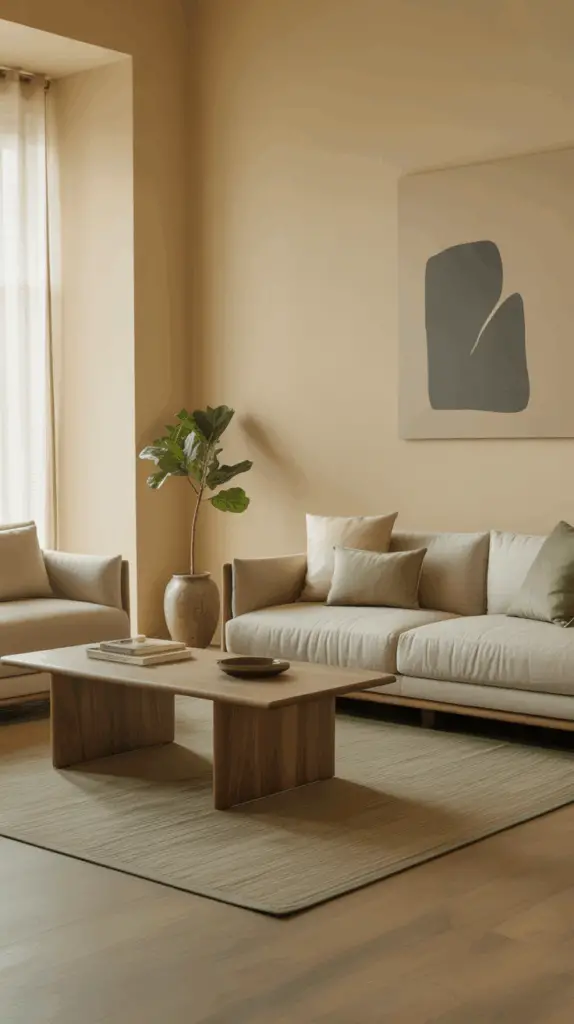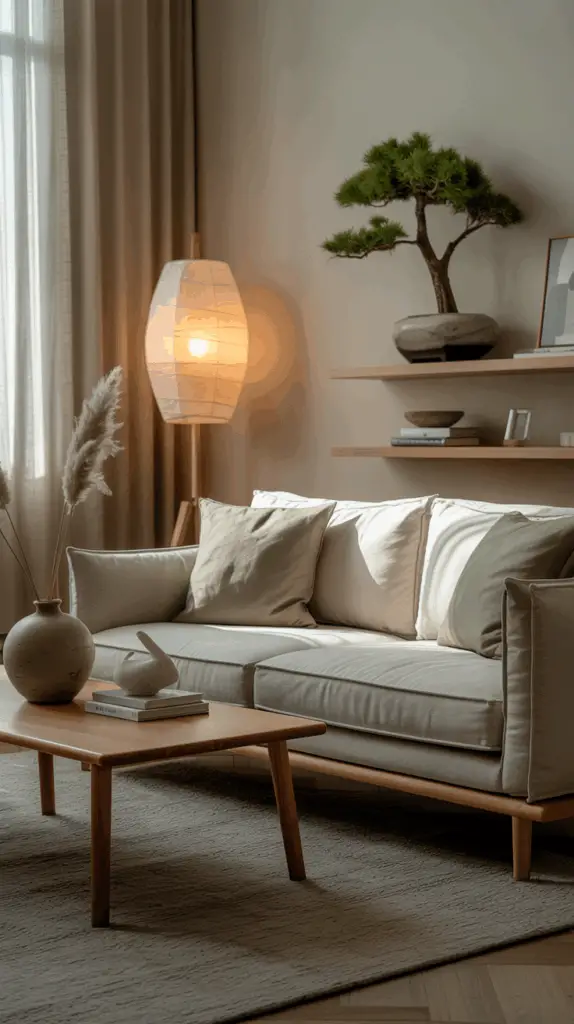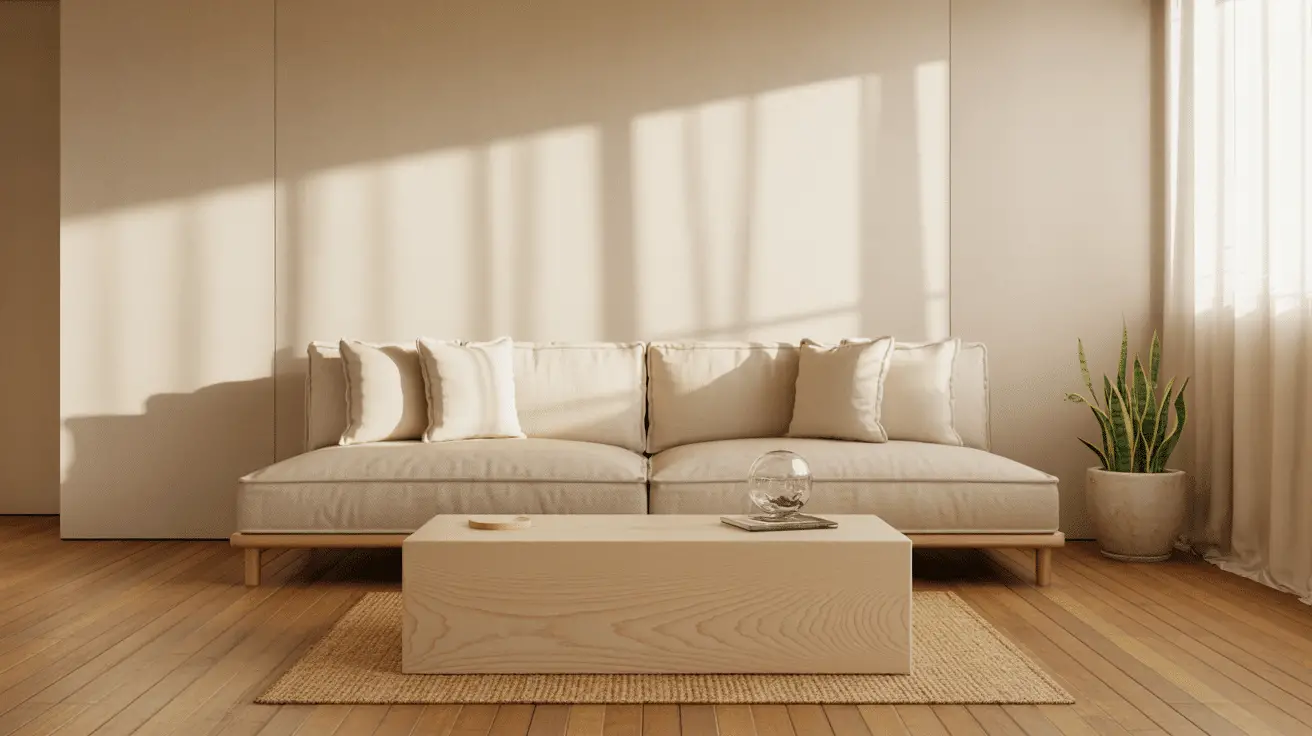How to Style a Japandi Living Room for a Peaceful and Harmonious Home
Table of Contents
Introduction
Imagine stepping into a living room that feels both serene and stylish—where every element has been thoughtfully curated to create a sense of balance and tranquility. This is the essence of Japandi style, a fusion of Japanese minimalism and Scandinavian functionality. Japandi is a design philosophy that embraces clean lines, natural materials, and an overall calm atmosphere, making it perfect for creating a peaceful, harmonious home.
In today’s fast-paced world, it’s easy to feel overwhelmed by clutter and chaos. Japandi offers a solution by focusing on simplicity and the beauty of functional design. Whether you’re aiming to declutter your space or simply want to refresh your living room with a calming aesthetic, Japandi style offers a refreshing approach to home decor. But how exactly do you achieve the perfect balance between Japanese Zen and Scandinavian coziness?
In this post, we’ll walk you through key steps to styling a Japandi living room, focusing on minimalist furniture, natural textures, and soothing color schemes. From selecting the right materials to incorporating subtle details, these tips will help you transform your living room into a peaceful sanctuary that radiates harmony. Let’s explore how to bring the elegance of Japandi design into your home.
1. Embrace Simplicity with Minimalist Furniture
Japandi design is built on the foundation of minimalism, and the furniture you choose plays a critical role in setting the tone of the room. The key is to opt for clean, functional pieces that don’t overcrowd the space but still provide comfort and purpose. Minimalist furniture ensures the room feels open, airy, and serene.
Focus on Functionality
When selecting furniture for your Japandi living room, focus on functionality. Each piece should serve a purpose without excess decoration. For example, a low-profile sofa with simple lines and neutral upholstery will create a calm and inviting atmosphere. Choose furniture that’s comfortable yet unobtrusive, so it doesn’t overwhelm the space.
Natural Materials
Wood is a primary material in Japandi interiors, symbolizing the connection with nature that both Japanese and Scandinavian styles emphasize. Opt for light wood tones like oak or beech for furniture like coffee tables, bookshelves, or TV stands. The natural grain of the wood adds warmth to the room, balancing the minimalistic design.
2. Utilize a Soothing, Neutral Color Palette
Color plays a pivotal role in creating a calming atmosphere in any space, and in a Japandi living room, neutral tones are paramount. A soothing, neutral color palette promotes relaxation and helps to achieve the peaceful, serene vibe that defines Japandi interiors.
Earthy Neutrals
Think soft beige, warm grays, whites, and muted tones of green or blue. These shades create a natural, grounding effect that enhances the tranquil feel of the room. Avoid bold, bright colors that can feel jarring or overwhelming. Instead, focus on creating a space where each element feels cohesive.
Accent Colors
While the base color palette is neutral, adding a few accent colors can introduce depth and interest. Opt for muted tones like sage green, terracotta, or soft browns. A single, well-placed accent can serve as a focal point, such as a cushion, a rug, or a vase, without disrupting the overall tranquility of the room.

3. Incorporate Natural Materials and Textures
Natural materials are essential to the Japandi aesthetic, as they evoke a sense of calm and connection to nature. The use of wood, stone, textiles, and plants brings texture and warmth to the room, creating a cozy yet understated environment.
Wooden Furniture and Accents
As mentioned earlier, wood is a fundamental element in Japandi design. Wooden furniture, such as a coffee table or bookshelf, adds texture and warmth. You can also include wooden accessories like trays or frames to subtly reinforce the theme. Darker wood tones add elegance, while lighter woods give a more Scandinavian touch.
Textiles and Fabrics
Textiles also play a significant role in Japandi design, but they must be carefully selected to maintain simplicity. Choose natural fabrics such as linen, cotton, and wool for cushions, throws, and curtains. Opt for muted tones and subtle textures to maintain the calm, clean aesthetic. A woolen throw on a simple sofa, or linen cushions on a minimalist chair, adds comfort without cluttering the space.
Indoor Plants
Plants are an easy way to bring nature indoors and enhance the Japandi vibe. Choose low-maintenance plants such as ferns, succulents, or bonsais. Their organic shapes and calming green hues complement the natural materials in the room. Place plants in simple pots made of ceramic, stone, or wood to tie everything together.

4. Focus on Decluttering and Smart Storage Solutions
In any Japandi space, simplicity is key, and this extends to the way you store your belongings. A clutter-free environment not only looks better but also contributes to a sense of calm and order, essential to the Japandi philosophy.
Hidden Storage
Consider using storage furniture that blends seamlessly into the room. Opt for low-profile storage units with clean lines, like a storage ottoman or a minimalist sideboard. These pieces can be both functional and beautiful, storing your essentials without disrupting the room’s serene aesthetic.
Open Shelving
Incorporate open shelving where you can display a curated selection of items, like a few books, vases, or plants. The goal is to keep the display minimal and avoid overcrowding the shelves. This promotes a clean, uncluttered look while still allowing you to showcase elements of your personal style.
Declutter Regularly
Japandi style thrives on a sense of simplicity, so it’s essential to regularly declutter your living room. Keep only the items that bring joy or serve a functional purpose. The fewer items you have, the more open and calming the room will feel.
5. Add Personal Touches with Minimalist Art and Decor
While Japandi style is rooted in simplicity, it doesn’t mean your living room has to feel sterile or devoid of personality. Thoughtfully chosen art and decor can add warmth and individuality to the space without compromising its minimalist appeal.
Minimalist Art
Select artwork that enhances the tranquil vibe of the room. Consider abstract prints, monochrome photography, or even traditional Japanese ink drawings. The key is to avoid anything overly busy or colorful. Opt for artwork that complements the room’s natural tones and evokes a sense of peace.
Subtle Decorative Pieces
Incorporate subtle decorative items that enhance the peaceful atmosphere, such as ceramic vases, handmade pottery, or a single sculptural object. These pieces can add personality and texture to your living room while maintaining the Japandi emphasis on quality over quantity.
6. Use Soft Lighting to Create a Cozy Ambiance
Lighting is one of the most important elements in a Japandi living room, as it can dramatically affect the overall mood of the space. The lighting should be soft and warm, contributing to the peaceful, relaxed atmosphere that Japandi interiors are known for.
Layered Lighting
Use a combination of ambient, task, and accent lighting to create a balanced, layered effect. Opt for soft, warm light bulbs in simple, understated light fixtures. For example, a minimalist pendant light or a Japanese-style lantern can add character while keeping the space tranquil.
Table Lamps and Floor Lamps
Table lamps with natural materials, such as wood or stone bases, add warmth and functionality to the space. Floor lamps with dimmable features can be placed near seating areas to provide cozy, adjustable lighting.
Natural Light
Maximize natural light by keeping window treatments simple. Opt for light linen curtains or bamboo blinds that allow the daylight to filter in, creating an airy and open environment.
7. Balance Form and Function in Your Layout
The layout of your Japandi living room should be designed with both form and function in mind. The goal is to create a space that is not only aesthetically pleasing but also practical and comfortable for daily use.
Consider Flow and Accessibility
Ensure that the room layout encourages easy movement and accessibility. Keep pathways clear and allow for a comfortable flow between seating areas and other parts of the room. A central seating area with a low coffee table encourages social interaction and relaxation.
Create Zones
Consider creating distinct zones within your living room, such as a reading nook with a comfy chair, a small meditation corner with a plant, or a designated entertainment space. This organization adds structure while maintaining the open, uncluttered feel of the room.
Conclusion
Styling a Japandi living room is all about finding harmony between simplicity, functionality, and natural beauty. By embracing minimalist furniture, neutral color palettes, natural materials, and thoughtful storage solutions, you can create a space that feels peaceful and welcoming. The Japandi aesthetic fosters a sense of calm and serenity, making it the perfect style for a modern home that prioritizes both form and function. With these simple tips, you can transform your living room into a peaceful sanctuary that is both beautiful and harmonious.

